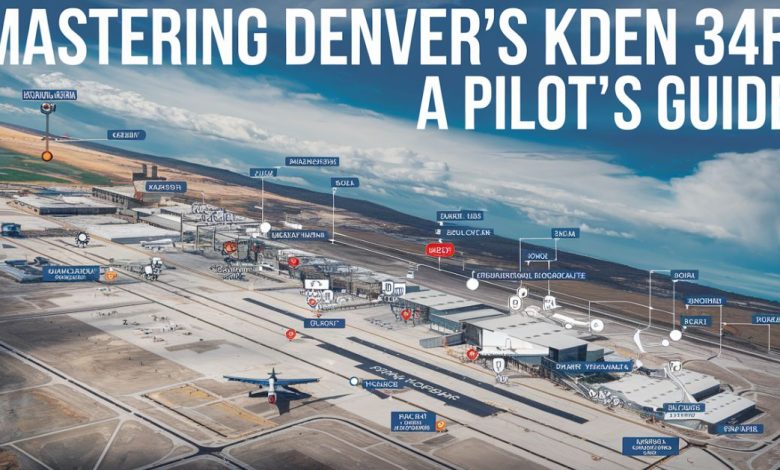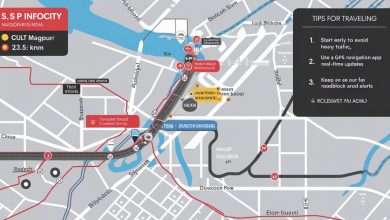Mastering Denver’s KDEN 34R: A Pilot’s Guide

Introduction
KDEN 34R is one of the most active at Denver International Airport with an important role of handling a large flow of domestic in addition to international traffic. Being popular for its geographical location, it provides a significant part in maintaining the traffic flow of the sky to be smooth and uneventful. Whether you are a fan of aeroplanes and willing to travel a lot or a person who is flying from time to time, you will find the significance of this particular runway interesting.
Want to know why KDEN 34R is so essential to the airport’s operations? Keep reading to learn more about its unique characteristics and role.
This runway is integral to how Denver’s airport handles high traffic volumes and challenging weather conditions.
KDEN 34R is a vital runway at Denver International Airport, facilitating numerous takeoffs and landings daily. Located at one of the nation’s largest airports, it ensures efficient handling of both passenger and cargo flights. Designed to manage high traffic and challenging weather, it’s a cornerstone of airport operations.
Why KDEN 34R is Vital to Denver International Airport Operations
Runway KDEN 34R plays a pivotal role in keeping Denver International Airport’s (DIA) air traffic moving efficiently. It is one of the longest runways, allowing for the accommodation of large aircraft such as wide-body jets. Its parallel layout with other major runways ensures that planes can take off and land simultaneously, minimizing delays. This runway also serves as a key asset during bad weather, providing a safe and well-maintained surface for aircraft operations. In a busy airport like DIA, the primary runway is crucial for maintaining smooth air traffic.
The Construction and Specifications of KDEN 34R
Built with precision, KDEN 34R was designed to handle both large aircraft and diverse weather conditions. The runway spans over 12,000 feet, making it long enough to accommodate heavy jets and international flights. Durable materials make up its surface to withstand the extreme temperature fluctuations typical of the Denver area. In addition, advanced lighting systems on the runway help guide aircraft safely during night operations or in low-visibility conditions. The runway’s width also allows for a margin of safety, especially during crosswind landings, making it an engineering marvel in the aviation world.
How Weather Impacts Operations on KDEN 34R
As it is apparent from the weather patterns of Denver, the weather condition there is quite fluctuating and that is why it is extremely important for the airport to have a resource such as KDEN 34R. The taxiway also has stand alone de-icing systems so that it can easily clear the runway in case of a snow storm or any type of icy condition. This has the added bonus of the planes needing a measure more distance to take off due to the thin air at high altitude and for which KDEN 34R’s length is such an advantage. In bad or ‘Red Alerts’ weather conditions such as high winds or snow, KDEN 34R remains open to allow those planes that would otherwise be grounded to be evacuated further enhancing the safety of passengers as well as maintaining proper operations of the airport.
Traffic Management and Efficiency on KDEN 34R
Operations of upto 34R flights per day help in easing traffic at the Denver International Airport. It also works in collaboration with the airport’s parallel strips thus enabling multiple arrival and departures, hence cutting down the time spent by airplanes on the tarmac. For instance, air traffic controllers ensure that the KDEN 34R helps in guiding the inbound and outbound flights particularly in the busy periods. The runway also plays a crucial role in handling flight diversions and managing traffic when other runways are closed for repair. These characteristics place it conveniently within the airport layout and make it achieve a consistent throughput air traffic and varying airport capacity.
Future Developments Planned for KDEN 34R
As the Denver International Airport expands over the years, it has future development plans for the KDEN 34R with goal of enhancing it and making it bigger and more effective. It is also being debated whether the runway should be extended so as to accommodate even larger planes or if further sophisticated navigation aids should be incorporated. Sustainability is also an area which the airport could look at as to how the runway will be constructed in a more efficient with less impact on the environment with better material and techniques. All of these upgrades will not only enhance the performance of the runway but will also aid the Denver International Airport to remain among the busiest airports in the U. S.
FAQ’s
How long is KDEN 34R?
KDEN 34R is approximately 12,000 feet long.
What types of aircraft can use KDEN 34R?
It accommodates everything from smaller regional jets to large wide-body aircraft.
Does the airport use KDEN 34R in bad weather?
Yes, it handles operations during challenging weather conditions like snow and wind.
Can international flights use KDEN 34R?
Yes, international flights regularly use this runway for takeoffs and landings.
What makes KDEN 34R important to Denver International Airport?
Its length and layout are essential for managing high traffic and large aircraft.
Conclusion
Runway KDEN 34R is a key in Denver International Airport operations and plays a great role in ensuring that the airport accommodates many aircraft traffic. Currently the runway is long and its surface is durable and equipped with the latest technology it also provides smooth take off and landing regardless of the whether it is in Denver. Furthermore, the airport relies on its main runway to meet current activity flow and prepare for future expansion. The fact that this is one of the most used runaways can in no doubt be over emphasized, its efficiency and organization is crucial for the daily operation of the sky in Denver.




